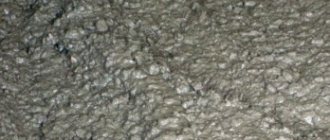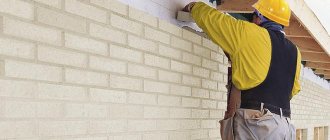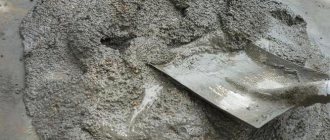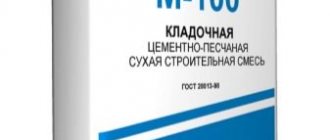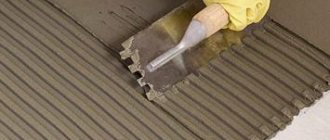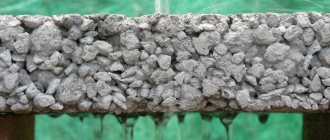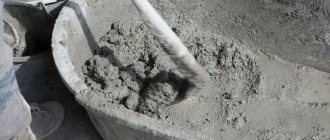SOLUTION BRAND M50
Order
| Brand | Frost resistance F | Styling brand | Price per 1 m3 (with VAT 20%) | |
| Masonry | Mounting | |||
| M50 | 75 | PC3 | 2700 rub. | 2240 rub. |
One of the most popular mortars based on cement, additives and sand is M50. It is used in almost all construction work related to the construction of walls, the preparation of horizontal foundations (screeds), and the repair of cracks, irregularities and other defects. It is produced in accordance with GOST 28013-98 and delivered to consumers completely ready for use in special machines (automatic mixers).
Masonry mortar grade M 50
This mixture is presented to the technical characteristics of M-50 Pk F50. Brand M50 is a simple mixture with a strength class of B3.5. This product contains water, binder and filler.
Cement m400 price and technical characteristics are indicated in the article.
In order to improve the technical qualities of M50, plasticizers, retarders of setting time and reduction of delamination are added to its composition. Thanks to this unique composition, you can get a durable and reliable structure that is not afraid of negative influences.
How to properly use cement grade M 500 can be emphasized for yourself from the article.
What is lime plaster
Adding lime to solutions can significantly increase the ductility and crack resistance of plaster. It becomes much easier to work with, it does not dry out as quickly, it even sticks easily to wood, and the surface is smoother and free of defects. It also provides excellent protection against mold and mildew. Another indisputable advantage is its environmental friendliness - unlike synthetic additives, lime is absolutely harmless.
Lime is widely used in construction as a plasticizer. However, when plastering facades, it should be taken into account that it can only be used in areas with a dry climate. Such solutions are not recommended for use in rooms with high (over 60%) humidity.
Lime plaster is considered warmer and more vapor-permeable, that is, “breathable,” and it is much easier to remove it from the walls in case of repairs than, for example, ordinary cement plaster. But excess lime can weaken the strength of the surface. That is why it should be added in moderation, strictly adhering to the proportions.
As you can see, lime plaster has many advantages. The disadvantages include not such high strength as that of cement compositions. It is also not recommended to use it in damp areas and
But such a solution does not require special strength. After all, the purpose of plastering is to level the surface and cover up small cracks. A more durable solution is required when laying. However, even in this case, according to SNiP, it is allowed to add a small amount of lime paste or clay to it to increase plasticity.
When slaking lime, you should be extremely careful - splashes of the hot mixture can cause burns. The smallest lime dust that can settle on the mucous membrane also has a harmful effect. Therefore, when working, you should use protective clothing, gloves and a respirator.
Lime-cement mixture M75
This mortar is classified as masonry mortar. It is characterized by high strength indicators and a degree of water resistance. I use it in the construction of construction and industrial facilities. M75 should be classified as a complex mixed product; it is characterized by strength class B5 and strength 75 kg/m3. Construction cement mortar GOST 28013 98 consists of specially selected components, thanks to which it is possible to obtain a solid material.
During preparation, it is necessary that all components are thoroughly mixed, and this can only be achieved if the production process takes place in a factory where modern equipment is used.
What the brand of cement means can be found in the article.
In addition, the strength indicators are affected by the ambient temperature. If the temperature at the time of hardening has decreased, this will negatively affect the strength. If there is a sharp decrease in strength, freezing may occur during the hardening stage.
If the masonry process is carried out in a hot climate, this will lead to rapid evaporation of moisture from the top layer of the mixture, which may cause a decrease in strength.
A solution of ready-made masonry cement grade 100 according to GOST is used exactly as indicated in the article.
M75 may have the following technical characteristics:
- moisture resistance W6-W8,
- frost resistance F50-F200,
- mobility Pk1-Pk4.
To improve all the quality characteristics of the product in question, it is necessary to add auxiliary ingredients and plasticizers to the composition. They are able to increase the plasticity and density of concrete mortar. In addition, it is possible to slow down the setting process when delivering it over long distances.
Read our article for more details about what lime is.
What is the composition of cement m400 can be found in the article.
Ready mixes
In order to simplify the technology for preparing mortars, today in the hardware store there is a range of offers of mixtures, when diluted with water, a ready-made masonry mortar .
This is a popular product among consumers, since preparation requires adding only a certain amount of clean water - detailed instructions on the package.
Based on the required mixing volumes, use either a hand mixer or a concrete mixer. The process takes 5-8 minutes.
Technical characteristics of M100
This product should be classified as masonry, which is characterized by high strength and water resistance. It is in great demand in the construction of civil and industrial facilities, for which the design strength will be equal to the composition and properties of the solution in question.
Compared to M100 concrete, M100 mortar does not contain crushed stone. Only construction sand that meets state standards can be used as a filler.
Cement cement testing methods in accordance with GOST GOST 26798.1 96 are indicated in the article.
M100 is characterized by strength class B7.5, and strength is 100 kg/m3. All components included in the product are thoroughly mixed using special technological equipment, especially building lime.
The strength properties of the solution are influenced by the ambient temperature. If the air temperature has decreased, then the hardening time of the composition has also decreased, which sharply reduces its strength. Elevated temperatures are also undesirable, since in this case moisture from the upper layers of the solution evaporates and the strength decreases.
What is the volumetric weight of cement m500 can be read in the article.
For the M100, the following technical characteristics can be distinguished:
- degree of resistance to moisture – W6-W8,
- degree of frost resistance F50-F200,
- mobility Pk2-Pk4.
In order to improve the strength properties of the solution, it is necessary to use additives and plasticizers. Thanks to these auxiliary additives, it is possible to slow down the setting and increase the density of the product.
Basic Rules
The source material must be of the best quality, since neglecting this factor can negatively affect the quality of the work done. When plastering walls, both brick and wooden, only high-quality raw materials should be used . Before mixing the starting materials, you need to make sure that they have sufficient flowability. Crumpled mixture and foreign solids may indicate that the raw material has been exposed to moisture. This factor completely negates all the adhesive properties of the solution and, after hardening, makes it extremely fragile.
An important factor is that the use of masonry mortar for bricks, which contains lime, can only be used when plastering walls and other concrete surfaces. To process various kinds of cornices and other interior/exterior elements, it is necessary to choose cement that boasts good durability, such as cement grades M400, M75, M50 and M25 according to GOST 28013-98.
In order for the plaster coating for walls or screed to last for a long time, you must comply with all the necessary requirements during the procedure of mixing dry components. For finishing types of mortar, it is worth using fine river sand as a filler, which must first be sifted through a sieve.
You also need to ensure that the mixture is not too “greasy”; this factor can significantly spoil the quality of the final coating because After the material has dried, cracks may form. To improve the physical properties of concrete, at the stage of mixing the components, it is recommended to add various plasticizers, as well as PVA glue or liquid soap.
It is also worth taking into account that some types of masonry mortar for bricks, for example, M25, M75 and M100 according to GOST 28013-98, cannot be produced by handicraft methods, due to the complex preparation technology using high-tech equipment, thanks to which an amazing degree of mixing of components is achieved.
Plaster composition and proportions
To carry out the plastering process, it is necessary to prepare a solution that would consist of a binder and filler. To obtain the mixture, you need to use lime dough and sand. The proportions of the solution for plastering walls with your own hands are 1:3. Add liquid to bring the mixture to the desired consistency. A prerequisite for preparing a high-quality solution is thorough mixing of all components.
What is the price of dry cement-sand mixture m 150 indicated in the article.
If it is necessary to give the solution in question the necessary strength, it is worth adding 1/10 of the resulting volume of cement.
As a result of following all the recommendations, you will receive a cement-lime mixture.
The presented solution has a hardening time of at least 2-1.5 days. If you want to get a composition with a short hardening time, then during production you need to add gypsum. Thanks to this ingredient, it is possible to achieve hardening of the solution within 6 minutes, and complete hardening is observed after 30 minutes. But using such a solution is not always convenient; special skills will be required here, however, the plaster will have high strength indicators.
You can prepare limestone with the addition of clay. These ingredients are taken in a 1:1 ratio. After this, be sure to add sand in an amount of 5 parts. The resulting mixture will be much stronger than just lime and clay.
What is the price of cement m 500 indicated in the article.
In the video - cement-lime mortar for plaster, proportions:
The composition of the cement-sand mixture is indicated here.
Brand M200/M250
Mortars M200 and M250 are recommended for pouring paving surfaces, as well as preparing reinforced concrete belts and floors. Suitable for the construction of brick and block masonry, as well as sealing construction joints and restoration of facades.
Produced from cement and sand in proportions 1:3 (200) and 1.26 (250). For the preparation of mixtures the following are used:
- PC: 420 kg – for M200/ 440 kg – for M250;
- fine filler – 1460/1420 kg;
- sealer – 250 liters.
The building materials have improved technical characteristics: frost resistance – F150 and water resistance W4.
Preparing a mixture for laying bricks
Lime composition for bricklaying has lower strength indicators than cement. However, it is very warm and has great ductility. In addition, the process of laying the mortar is very easy and quick-setting. For preparation, you need to use slaked lime, sand and water. Mix all ingredients thoroughly. Such a solution is very rarely used in the construction of one-story houses, most often for masonry work inside the house.
Lime-cement today is used not only for laying bricks, but also for plastering surfaces. If all proportions and manufacturing technology are observed, it is possible to obtain a high-quality solution that will guarantee a long service life under the influence of negative influences.
Making your own solution
First you need to slak the lime for the plaster so that it is suitable for work. This requires a metal container, since the reaction is accompanied by a large release of heat and an increase in volume by 3 times. The lime packaging indicates the slaking speed: slow (25 minutes or less), fast (8 to 10 minutes), medium, 15 to 20 minutes. It is better to mix the mixture with a shovel or oar. Slaking is carried out for at least a day, however, ideally use lime that has been standing for a month.
The note! The sand also needs to be prepared before preparing the plaster: remove impurities, clean it by passing it through a sieve.
Instructions for creating a limestone-sand mortar:
- Sand is mixed with lime paste in the selected proportion. This is done dry and mixed thoroughly.
- After which water is gradually added to the container. There is no need to pour in the entire volume at once; it is poured in in a thin stream, and the solution is constantly stirred.
Now that the preparation is complete, you can begin plastering the surface.
Component proportions
The standard composition is a proportion of 1 to 4. The first number is lime, the second is sand. In the case of gypsum, the numbers change to 3 to 1, and if you add cement, then the proportions are 2 to 1.
To determine if the mixture is viscous enough, dip a spatula into it. If the liquid mass drains easily from it, it is necessary to add a plasticizer to the composition, because the viscosity is insufficient.
If the spatula has difficulty getting into the mixture, the solution needs to be thinned. Good viscosity is visible in the photo below. You will get excellent adhesion to the wall.
